
Brief | 2023
Case Study – Storing Green Hydrogen to Safeguard Energy Security
Over the next several years, the Department of Energy plans to distribute over $9.5 billion in federal funding to support clean hydrogen market formation across the United States. With hubs and projects poised for rapid development, it’s an opportune moment to assess an under-explored benefit of scaling new clean fuel production: deployable hydrogen can promote energy security and resiliency, for the United States and for its international partners.
Over the past year, RMI has exchanged data and information with Hy Stor Energy, a company with plans to establish a clean hydrogen hub in Mississippi. Natural salt domes there offer ideal conditions for hydrogen storage, enabling flexibility and dependability in Hy Stor’s operations. The company’s transparency and data provision has allowed us to identify and analyze the energy security benefits of building out clean hydrogen hubs across the United States, particularly when hydrogen production can be coupled with reliable long-term storage.
Key Findings
- Geologically stored green hydrogen offers unique energy security benefits to critical industries navigating heightened geopolitical and environmental risks and will enable the Mississippi Clean Hydrogen Hub (MCHH) to deploy green hydrogen flexibly and rapidly toward priority sectors facing rising fuel costs and possible outages.
- The MCHH is well located to provide energy to large industrial and transportation customers across the Gulf Coast — i.e., 52% of total US refining capacity, 44% of shipping capacity, 19% of steelmaking capacity, and 17% of heavy-duty trucking.
- A hub with large-scale, long-duration hydrogen storage and access to major transportation and logistics corridors can support expanded domestic green fertilizer production – by transporting green hydrogen feedstock to key agricultural sites via the Mississippi River, the MCHH can boost new green fertilizer manufacturing in the Midwest and reduce US exposure to volatile international agri-nutrient/fertilizer markets.
- Offering a secure, accessible zero-carbon energy supply, stored hydrogen facilities can attract new industrial manufacturing capacity to the Gulf Coast, reducing US dependence on import commodities including steel and plastics and enabling the buildup of a fully integrated domestic green hydrogen supply chain.
- Beyond promoting domestic energy security, the MCHH will support energy resilience through trade with strategic partners currently threatened by geopolitical and natural risks.
- In coordination with ports in Europe, the MCHH will deliver green hydrogen to the EU, helping it diversify energy imports and move away from Russian fossil fuels permanently.
- Through well-established shipping routes, the hub can also deliver green hydrogen to island and coastal nations in Latin America and the Caribbean, where it can provide a secure fuel for delivery vessels and replace diesel in the microgrid generators that provide backup power to critical facilities.
- Public support from the Infrastructure Investment and Jobs Act (2021) and the Department of Energy could unlock billions in private investments across the Gulf region between now and 2026, with most spending directed toward large-scale critical infrastructure that will serve as the backbone of a reliable national hydrogen network.
- The hub’s aim to maximize zero-carbon product procurement will drive demand for green commodities across the hydrogen supply chain, unlocking additional investments in decarbonized manufacturing and renewable energy.
- Providing a flexible source of secure energy to plants facing potential outages, the MCHH could collectively save US industry millions in avoided losses.
- The hub’s location and scale can serve as a national strategic hydrogen reserve for the United States and strategic trading partners — with capacity for years’ worth of hydrogen storage and access to critical shipping corridors.
Sustainable, Reliable Energy within Volatile Fossil Fuel Markets
Over a year into a global energy security crisis, fossil fuel prices remain volatile, oscillating around price points higher than historical averages. Rising costs for coal, crude oil, and natural gas have hurt household and industrial consumers alike. Faced with continuously high fuel prices in 2022, critical industries pushed governments to procure more reliable energy supplies. Public and private willingness to pay for secure energy will continue to grow as scarcity and price volatility persist.
The United States has not escaped rising fossil fuel prices despite its abundant domestic natural gas supply. US gas prices remained lower in 2022 than prices in Europe and Southeast Asia, but the country’s position as a net exporter of liquefied natural gas (LNG) exposes its market to international pricing dynamics. Volatility in the global gas market is steadily driving US prices higher, and with US suppliers compelled to increase exports, the gap between US and global prices continues to narrow (see Exhibit 1).
Exhibit 1: Trends in natural gas prices globally, 2022-2023 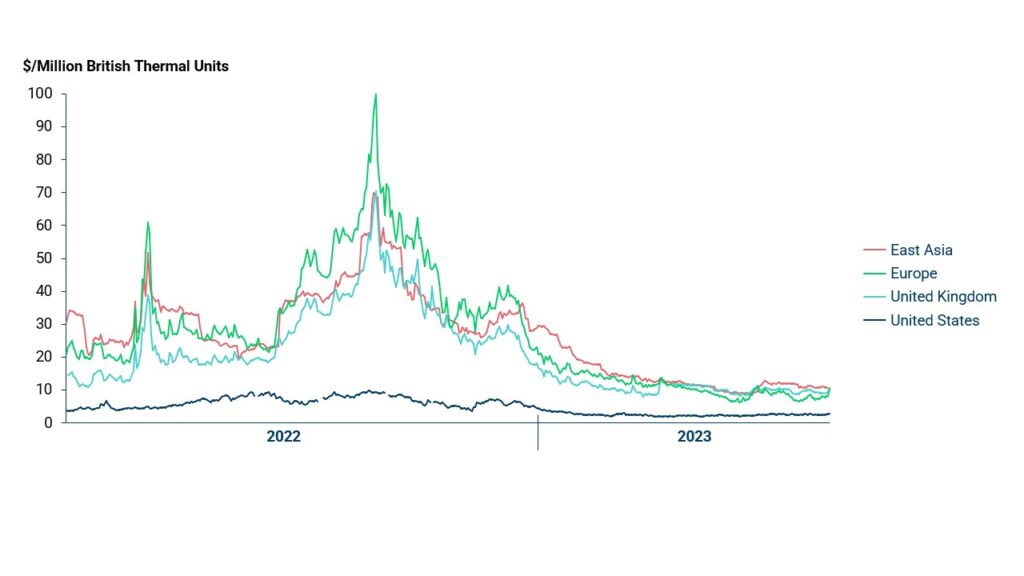
RMI Graphic. Source: Platts JKM; FRED Henry Hub; Trading Economics
This volatility has impacted business and government. US manufacturing and transport sectors reliant on natural gas, coal, and crude oil for fuel and feedstock are paying rising prices and, in some cases, struggling to procure sufficient energy to remain fully operational and still competitive. Politically, the US government is increasingly concerned with energy security, particularly given the sustained intensity of the energy crisis in Europe.
The EU’s strategy to replace Russian energy imports depends largely on ramping up its green energy supply. To displace fossil fuels in difficult-to-decarbonize sectors, the bloc has quadrupled its green hydrogen deployment ambition and plans to import 10 million tons of green hydrogen into its energy markets by 2030.[i] To avoid continued reliance on politically volatile export regions, Europe seeks to secure this green fuel via new relationships with reliable trading partners. A longstanding and valued trade partner, the United States is well positioned to support the EU with exports of green hydrogen and its derivatives.
Navigating an accelerated clean energy transition while prioritizing energy security will not be easy, and experts warn that Europe’s current crisis foreshadows the complexity and severity of energy crises still to come. Unpredictable geopolitics and climate-driven natural disasters will continue to threaten domestic and international energy security. Amidst this uncertainty, global players are recognizing green hydrogen’s singular energy security advantages — by replacing natural gas and other fossil fuels in difficult-to-decarbonize sectors, countries minimize their exposure to volatile export markets. In Latin America and the Caribbean, for example, where countries are highly dependent on shipping-based trade and increasingly threatened by climate risks, governments are now designing transition strategies that rely on green hydrogen to promote energy resilience.
Stored clean fuel offers critical security to resource-strained energy markets. The MCHH exemplifies this appeal: optimized to supply secure fuel for the Gulf Coast, it can also export emergency green energy to strategic international partners. The hub can execute a fully integrated approach — producing, storing, and distributing volumes of green hydrogen that can keep critical industry and transport operational while reducing greenhouse gas emissions. The hub’s unparalleled access to long-duration geological storage allows for crucial flexibility in supplying green fuel; by optimally exploiting its storage capacity, the MCHH can distribute green hydrogen to US industries whenever they’re threatened with outages. Stored green hydrogen can also be exported to European and Latin American countries via local deep water ports, aiding undersupplied markets and strengthening relationships with trading partners.
Resource Security for Critical Industries in the United States
The ramifications of the global energy crisis have reverberated across the United States, with unstable fossil fuel prices driving up energy costs for household and industrial consumers. Current instability is prompting policymakers to consider how geopolitical risk and natural disasters might threaten US energy markets. Federal and state governments are pushing to expand localized clean energy production primarily by building up renewable generation. But while US power markets can reduce their exposure to fossil fuels by expanding solar and wind capacity, heavy-duty industries and transport can’t achieve energy security solely through electrification. In these sectors, green hydrogen produced with renewables acts as fuel and feedstock — a guaranteed clean energy supply that can directly replace fossil fuels in critical manufacturing, transport, and agricultural operations.
The MCHH will produce and store green hydrogen for industrial and transport use throughout the Gulf Coast. Its salt cavern storage offers volume and flexibility, which will allow the hub to strategically supply other regions facing energy scarcity with a steady reserve of green fuel. Existing infrastructure links the hub to key US industrial and agricultural corridors (see Exhibit 2).
RMI Graphic. Source: RMI analysis.
With established access to these corridors, the MCHH can offer energy security to priority sectors including refineries, petrochemical (and plastics) manufacturers, steelmakers, heavy-duty trucking, and shipping, in addition to supporting increased domestic fertilizer manufacturing.
In the longer term, secure and accessible green fuel at the MCHH can also support new manufacturing capacity across the Gulf Coast, the Midwest, and the East Coast. Imported steel, fertilizers, and plastics can be replaced with new domestic supplies. Secure energy from green hydrogen can thereby promote expanded resource security in the United States, reducing the country’s exposure not only to volatile fossil fuel markets but also to volatile markets for commodities produced with fossil fuels. Attracting investment in green hydrogen capacity will also help prevent critical new steel and fertilizer plants from becoming stranded assets due to increased volatility in conventional feedstock pricing.
Fuel Security for Energy-Intensive Manufacturing and Transport
The MCHH is ideally located to provide secure energy for crucial US manufacturing and transport operations. Its salt cavern storage facility is near three major steel manufacturing clusters and eight of the top 10 US refineries with dozens of nearby petrochemical plants that manufacture plastics. The Gulf States are also home to 12 of the top 20 US shipping ports and substantial heavy-duty trucking capacity to transport fuel and goods between industrial sites. Exhibit 3 depicts the dense cluster of plants and ports the MCHH could supply with green hydrogen.
Exhibit 3: Concentration of critical industrial sectors surrounding the Mississippi Clean Hydrogen Hub
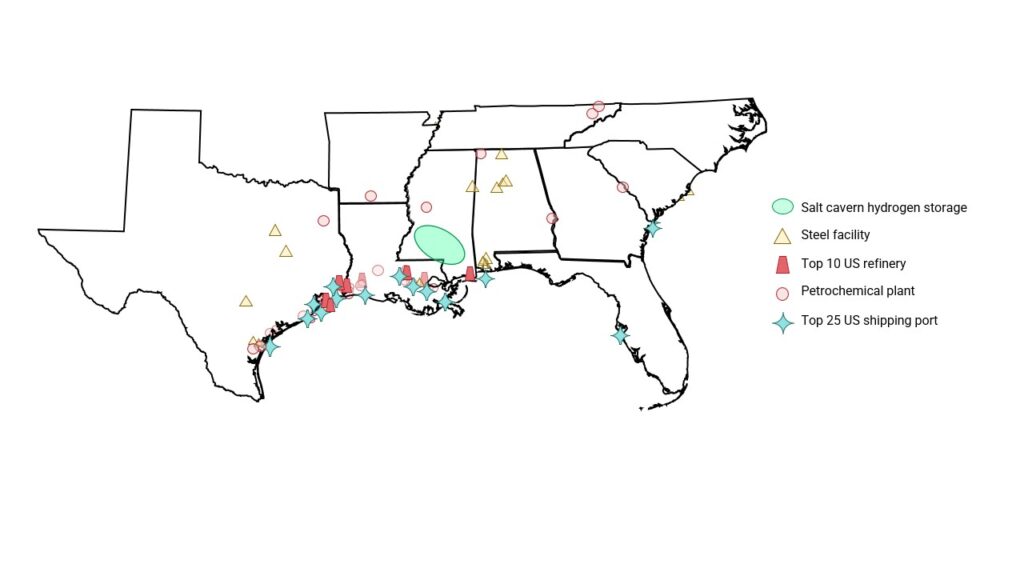
RMI Graphic. Source: American Iron and Steel Institute; Global Energy Monitor; US Energy Information Administration (EIA); American Fuel & Petrochemical Manufacturers; US Department of Transportation; American Trucking Association
Across the Gulf Coast and the Southeast, the hub could potentially offer backup fuel and feedstock to 52% of US refining, 44% of US shipping, 19% of US steelmaking, and 17% of US heavy-duty trucking capacity (see Exhibit 4). With access to the Midwest and the mid-Atlantic, the hub could provide energy to an additional 22% of refining, 21% of shipping, 74% of steelmaking, and 44% of trucking.
Exhibit 4: Proportion of US refining, shipping, steelmaking, and trucking capacity in the hub’s accessible market
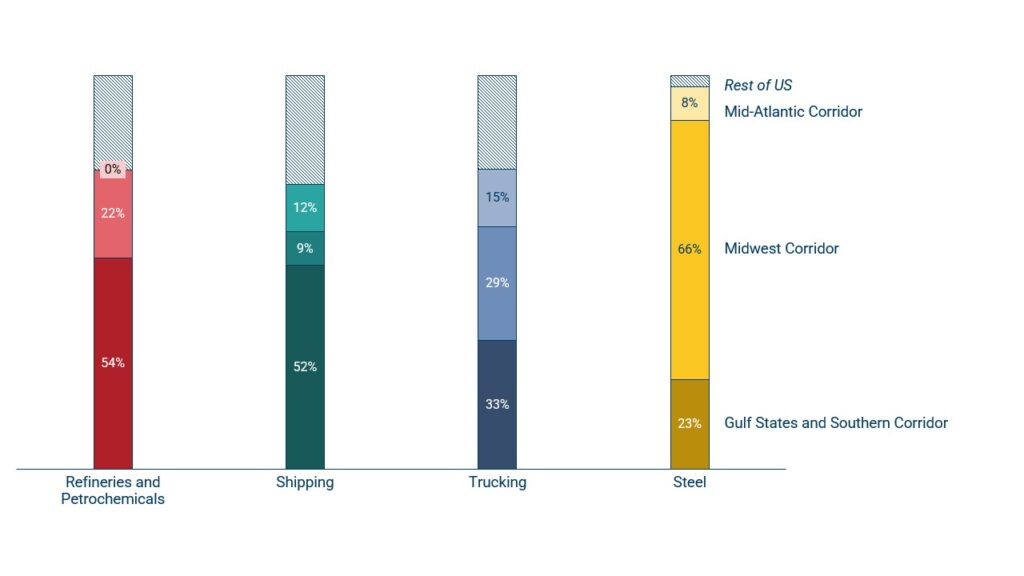
RMI Graphic. Source: American Iron and Steel Institute; Global Energy Monitor; US EIA; American Fuel & Petrochemical Manufacturers; US Department of Transportation; American Trucking Asociation
Lead time on hydrogen uptake for feedstock use varies by sector. In refining and petrochemical manufacturing, green hydrogen can immediately replace gray hydrogen as feedstock, but steel plants, shipping vessels, and heavy-duty trucks require technological adaptation to accommodate green hydrogen as fuel. So, demand for green hydrogen in the United States will rise as industry and transport sectors decarbonize. Exhibit 5 projects total demand for green hydrogen in refining and petrochemicals, steelmaking, shipping, and heavy-duty trucking in market corridors accessible to the hub. In addition to providing direct industrial feedstocks, hydrogen systems can also replace diesel generators, preventing disruptions in continuous power to hospitals, data centers, and users across a range of sectors.
Overall, the MCHH could ultimately produce millions of tons of green hydrogen per year and utilize its long-term storage facilities to flexibly deploy up to tens of thousands of tons at a time to priority demand centers. This deployment flexibility — enabled by salt cavern storage — will allow the hub to strategically divert green hydrogen toward resource-threatened sectors and regions. Critical industrial clusters and ports in the Southeast, the Midwest, and the Mid-Atlantic combined will drive up to 79% of demand for green hydrogen in the United States.
Exhibit 5: Projected total addressable demand from shipping, trucking, steel, and refineries in corridors accessible to the MCHH
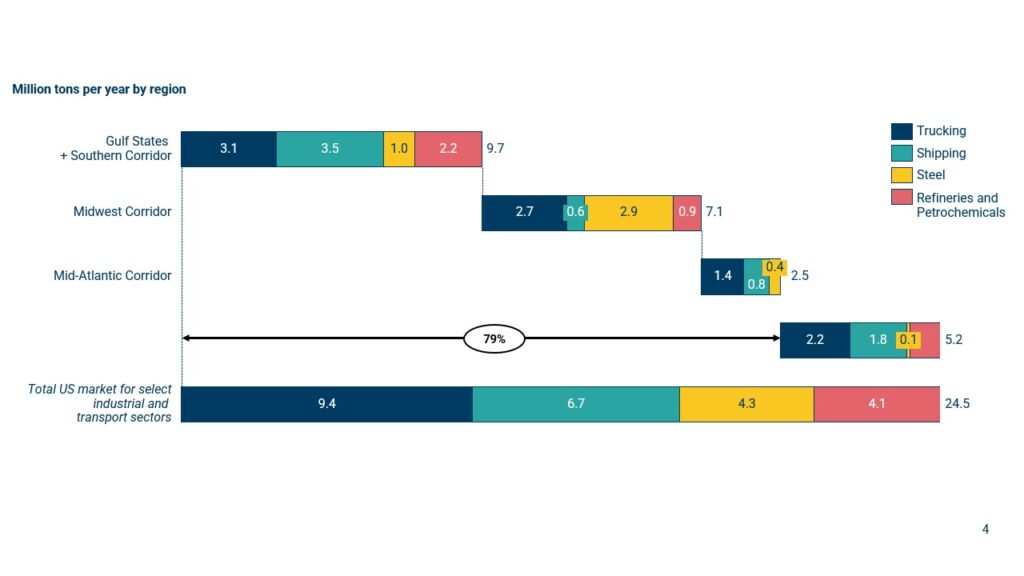
Note: Assumes demand for green hydrogen in refineries and petrochemicals falls by 40% from current levels. Does not consider increasing demand driven by economic growth.
RMI Graphic. Source: Global Energy Monitor; US EIA; US Department of Energy; RMI analysis
Fertilizer Security for Agriculture
Green hydrogen can also bolster energy security in fertilizer manufacturing. Green ammonia, a derivative of green hydrogen, is a key component in nitrogenous fertilizers. Most ammonia feedstock for fertilizers is currently produced with natural gas, so fertilizer prices have soared with rising natural gas prices, exacerbating global scarcity caused by the ongoing war in Ukraine. As a net importer of fertilizer, the United States is exploring how it can diversify its fertilizer sourcing and guarantee a steady supply for its agricultural industry.
Using green ammonia to manufacture fertilizers reduces sectoral exposure to unpredictable natural gas markets. The MCHH could offer fertilizer plants a steady supply of green hydrogen, enabling the United States to scale up its domestic manufacturing capacity and safeguard its agricultural operations from scarcity and volatility in global fertilizer markets.
Midwestern states drive US demand for nitrogenous fertilizers. The MCHH could supply green hydrogen feedstock to these critical agricultural areas via waterways, principally the Mississippi River. Through existing access routes with the Midwest Corridor, the hub could offer a secure supply of green feedstock to states with 67% of the US principal crop area planted. Exhibit 6 shows how existing transport networks along rivers in the Midwest will link salt cavern storage facilities at the MCHH directly to states with the highest demand for nitrogenous fertilizer. It also depicts several of the country’s largest domestic harbors where green hydrogen can be delivered.
Exhibit 6: Scaled fertilizer demand according to principal crop area planted by state
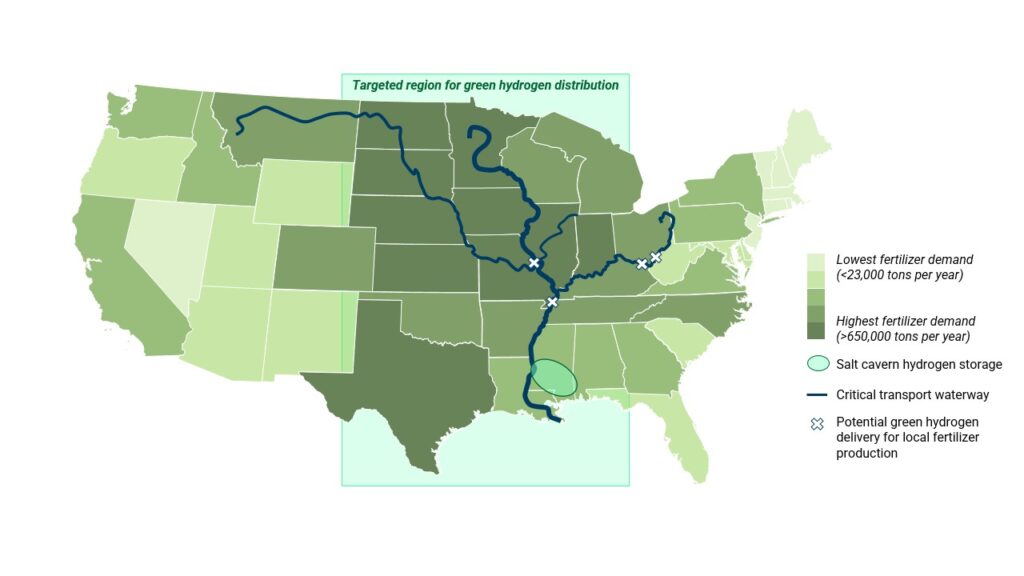
RMI Graphic. Source: Fertilizer Institute; US Department of Agriculture (USDA); Agricultural and Environmental Services Laboratories (AESL)
The combined green hydrogen market for fertilizers across the corridors accessible to the MCHH could eventually reach 3.2 million tons/year, primarily concentrated in the Midwest (see Exhibit 7). As with refining, steelmaking, and shipping, a hub that can exploit long-duration storage can strategically deploy green hydrogen to fertilizer manufacturers according to need.
Exhibit 7: Projected green hydrogen demand (total addressable market) for fertilizers in corridors accessible to the MCHH
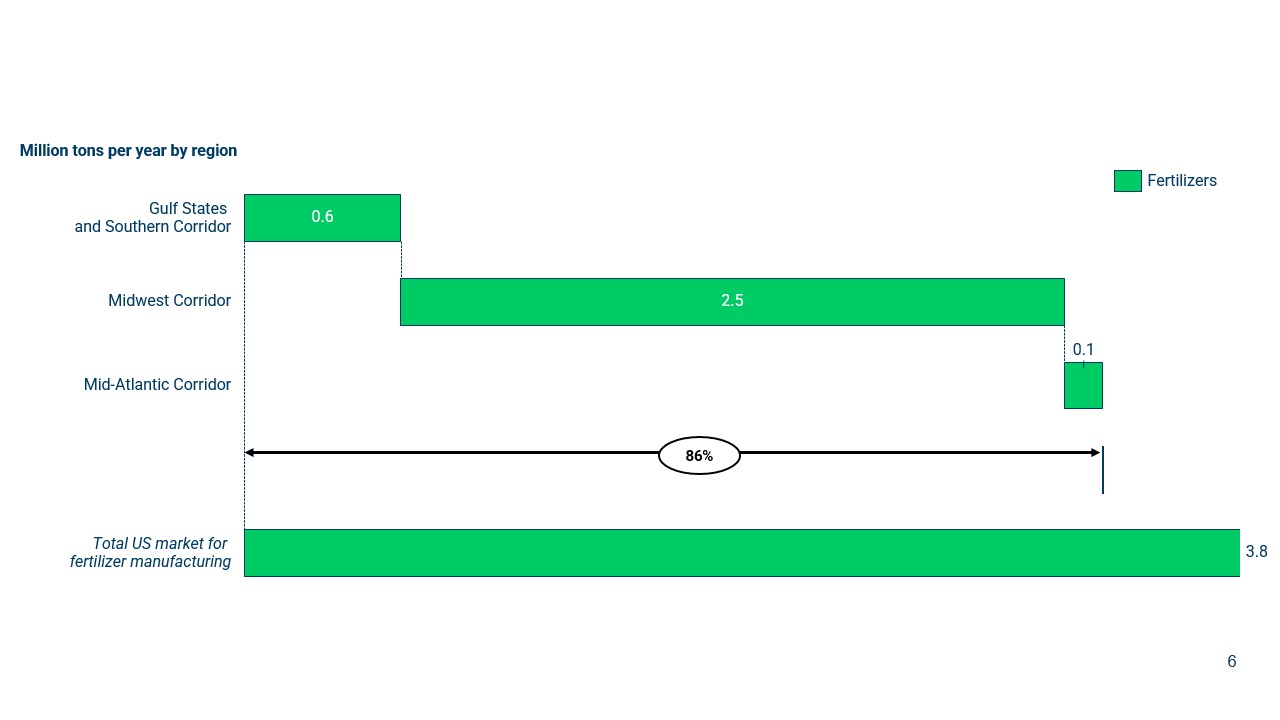
RMI Graphic. Source: Fertilizer Institute; USDA; AESL
Enabling New Domestic Manufacturing with the Promise of Secure Green Energy
To benefit from a green hydrogen-based fertilizer supply, Midwestern states are planning to expand domestic fertilizer manufacturing capacity. Green hydrogen can be delivered via river barges to ammonia conversion facilities, where fertilizer can be produced and distributed to regional farms. New domestic supplies will substantially reduce US dependence on fertilizer imports, limiting exposure to an unpredictable international commodity market. A steady supply of green hydrogen from a hub with long-term storage will instill confidence that new fertilizer manufacturing facilities maintain consistent production.
Similarly, a steady supply of green hydrogen could attract new industrial manufacturing capacity to the Gulf States and the United States more broadly. The country currently relies on high volumes of imported steel and plastic, which could potentially be produced at lower costs and with fewer emissions around the MCHH. In this way the hub could promote energy security for new plants and expanded domestic production, providing the United States an opportunity to reduce its reliance on imported fossil fuels and fossil fuel–based commodities, thus minimizing the risks of volatile trading markets.
Additionally, opting for green hydrogen will prevent new manufacturers from stranding assets in the long term. The hydrogen production tax credit in the Inflation Reduction Act (2022), or IRA, will ensure that steel is soon produced at lower costs with green hydrogen than with coking coal, threatening the competitiveness of existing and new fossil fuel-based steel production. The same tax credit will render fertilizer produced with green hydrogen cheaper than fertilizer produced with natural gas at current market prices. So new green facilities for both commodities will outcompete and outlast traditional plants, producing lower-cost goods by relying on a secure domestic energy source.
Diversified Energy Exports via Green Shipping Corridors for International Partners at Risk
In addition to serving domestic markets, the MCHH is preparing to build export capacity via existing deep-water ports in the region. The hub will work with local partners to establish green shipping and green hydrogen export corridors based in maritime centers with extensive experience in fuel provision and fuel export.
Catalyzing First-Ever Green Shipping Corridors
The MCHH could catalyze the development of zero-emissions shipping routes between major ports, allowing for the security of large-scale zero-carbon hydrogen supply at a sustainable price for first movers across the maritime shipping value chain.
With federal funding from the IRA (including a $3/kg hydrogen production tax credit for clean hydrogen), the United States is now positioned to produce the world’s lowest-cost zero-emissions shipping fuel, making it one of the most attractive locations to anchor green shipping corridors.
There is significant regulatory and policy momentum behind the development of flagship green shipping corridors, particularly a forthcoming corridor between the United States and Japan. The two nations, along with India and Australia, make up the Quadrilateral Security Dialogue, or Quad, coalition, which has committed to launching multiple green shipping corridors between member countries by 2030. The United States and Japan have also signed the Clydebank Declaration, which commits to implementing at least six green corridors by the middle of this decade to accelerate the deployment of zero-emissions vessels in coming years.
Bolstered by strong project economics and growing political will, a storage-centered clean hydrogen hub provides a promising opportunity to execute the first green hydrogen corridor between the United States and international partners.
By building up green hydrogen shipping and trade corridors across the Gulf of Mexico and the Atlantic Ocean, the MCHH can link to partners where geopolitical and natural risks threaten energy security. Europe faces different risks from Latin America and the Caribbean, but countries in both regions are prioritizing resilience strategies to secure long-term green energy supplies for their citizens. The EU is rapidly reducing its reliance on Russian fossil fuels while prioritizing accelerated decarbonization and pushing to diversify its imports through new agreements with trusted trading partners. Countries in Latin America and the Caribbean anticipate that climate-related natural disasters will continue to jeopardize their economies and livelihoods, adopting robust adaptation strategies for procuring backup energy sources. Storage flexibility will help the MCHH divert concentrated quantities of green hydrogen toward regions that need it most.
Energy Security for Europe
At the start of its ongoing energy crisis, the European Commission published “REPowerEU” — a plan to cut off Russian fuel imports largely by accelerating the green energy transition. Green hydrogen will play a substantial role as a substitute for gas in the EU’s energy-intensive industries and transport, with the potential to reduce reliance on Russian imports by 15%. This will require the EU to achieve its ambition of deploying 20 million tons of green hydrogen by 2030, partly by ramping up international procurement to establish a market for imports of 10 million tons/year.
The EU continues to mobilize funding to build its green hydrogen market. Tens of billions of euros will be invested in new import and distribution infrastructure, with further spending allocated to subsidy schemes that will support immediate integration of green hydrogen into EU industries. Germany and the Netherlands will initiate import procurement by leveraging H2Global, an EU-wide scheme to facilitate and fund early renewable hydrogen imports. By 2030, imports from reliable trading partners will be a key source of energy security for the bloc.
With plans underway to establish a green shipping corridor between Mississippi’s Gulf Coast and the North Sea, the MCHH will be able to deploy green hydrogen to one of the largest industrial clusters in Europe. European industry and transport in Northern Europe — particularly in Belgium, Germany, and the Netherlands — will drive demand for green hydrogen over the next decade and will benefit most from a secure green energy supply. By prioritizing exports to this region, the MCHH could offer exactly that advantage.
Energy Resilience for Latin America and the Caribbean
The Intergovernmental Panel on Climate Change and the World Meteorological Organization have warned that countries across Latin America and the Caribbean are particularly vulnerable to climate risks.[ii] Rising sea levels, sustained drought, extreme heat waves, and intense storms threaten island and coastal nations in the region, which are now rapidly implementing green adaptation strategies. Green hydrogen can promote energy resilience in these countries in two critical ways:
- Replacing standard fuel oils in shipping and becoming a secure source of fuel for vessels connecting countries to larger supplies of goods and services
- Complementing new renewable energy production in smaller quantities as a stored and dispatchable fuel, potentially replacing diesel as a secure backup fuel source for microgrid generators
Several established shipping routes already link the Gulf Coast and Mississippi to markets that can benefit from green hydrogen. The hub could supply ships in nearby Gulfport and New Orleans with green hydrogen to produce clean shipping fuel. Vessels can deliver green hydrogen (or its derivative, green ammonia) to make fuel available at receiving ports in the Caribbean and Latin America to fully decarbonize shipping routes across the region.
The hub can also strategically supply islands and coastal countries with small supplies of green hydrogen to bolster local energy security when needed. Exhibit 9 highlights four priority export markets and eight potential export markets for the MCHH.
Exhibit 9: Priority and potential markets for green hydrogen in Latin America and the Caribbean
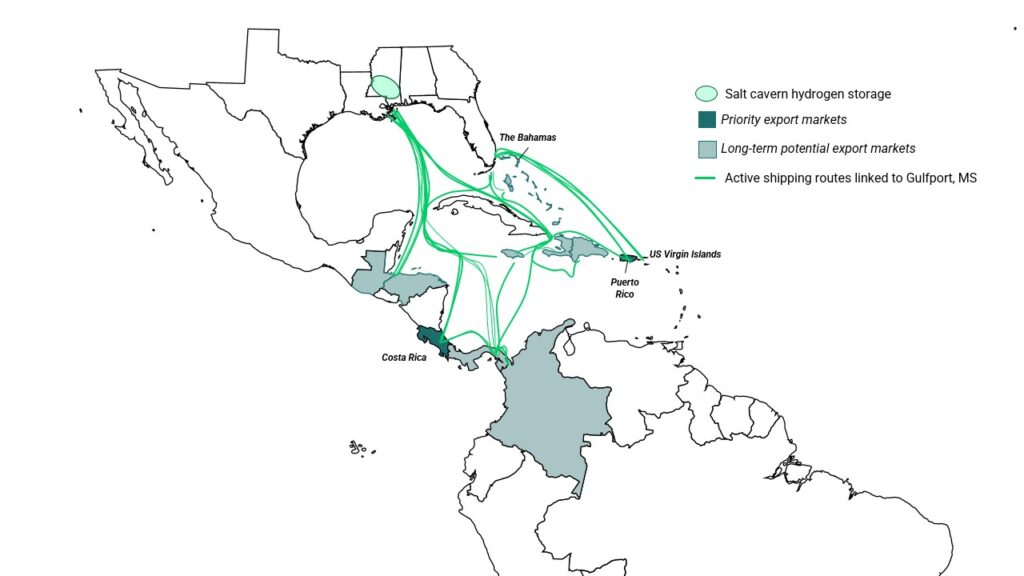
RMI Graphic. Source: RMI analysis.
In the Caribbean, the hub plans to strengthen links with the Bahamas, the US Virgin Islands, and Puerto Rico, which was ranked highest on the 2021 Global Climate Risk Index.[iii] All three have adopted policies calling for an accelerated energy transition that prioritizes energy security and resilience.[iv] Providing the islands with green hydrogen would advance this strategy while diversifying available fuel sources. Once the hub establishes export operations in the region, it could offer similar security to Puerto Rico’s neighbors (all with comparable climate risk indices), including the Dominican Republic, Haiti, and Jamaica. These islands could use even small amounts of green hydrogen as backup fuel when energy supplies are depleted or at risk.
In Central America, Costa Rica will be a priority export market for the hub, as the country plans to store green hydrogen imports as a backup supply for local generation as it builds its own production capacity. In the longer term, the hub potentially could expand its reach to Costa Rica’s neighbors Panama and Colombia, whose energy transition strategies also emphasize green hydrogen.[v] Colombia, with vast salt cavern storage capacity of its own, seeks to build a relationship with the MCHH to explore optimized production, storage, and export pathways. The hub could drive expansion of the region’s green hydrogen market and offer a secure backup energy supply as these countries decarbonize their industrial and transport operations.
Capitalizing on an Opportunity to Lock In Broad, Long-Term Security
Momentum is building to accelerate clean hydrogen market development, and to reduce US and international reliance on volatile fossil fuel markets. With the right support, the Mississippi Clean Hydrogen Hub can leverage its strategic location and unique storage capabilities to flexibly deploy a secure green energy supply to key industrial and transport operations.
An infusion of $500 million in public funding for the MCHH — the threshold for the US Department of Energy’s Clean Hydrogen Hub program, for example — could unlock billions in private spending for the Gulf region between now and 2026 with investments directed toward renewables and electrolyzers as well as critical infrastructure. The hub’s aim to maximize zero-carbon product procurement will drive demand for green commodities across the hydrogen supply chain, unlocking additional investments in decarbonized manufacturing and renewable energy.
Beyond stimulating investments in a green energy economy for the Gulf States, the MCHH could save regional manufacturing from expensive power outages. Plants can lose an estimated $5 million/day when they need to scale back or cut off operations due to energy scarcity.[vi] At standard operational rates, the hub could supply up to 90 plants a day with enough green hydrogen to keep their operations online,[vii] leading to hundreds of millions in collective savings by avoiding emergency shutoffs.
These benefits will scale as the MCHH scales, exemplifying how clean hydrogen hubs can offer a secure source of green energy for critical US sectors and for international partners.
[i] European Commission, “REPowerEU: A Plan to Rapidly Reduce Dependence on Russian Fossil Fuels and Fast Forward the Green Transition,” May 18, 2022, https://ec.europa.eu/commission/presscorner/detail/en/IP_22_3131.
[ii] United Nations, “It’s Climate Week for Latin America and the Caribbean,” July 2022, https://www.un.org/en/climatechange/latin-america-and-caribbean-climate-week.
[iii] Germanwatch e.V., Global Climate Risk Index 2021, https://www.germanwatch.org/en/19777.
[iv] Puerto Rico Energy Public Policy Act of 2019; and Division of Environmental Protections, Department of Planning and Natural Resources, US Virgin Islands.
[v] National Policy for Adaptation to Climate Change of Costa Rica 2018–2030 (PNACC); and Panama National Strategy for Climate Change 2050 (Executive Decree 34/2019).
[vi] Asim Hussain, “A Day Without Power: Outage Costs for Businesses,” Bloom Energy, October 2019, https://www.bloomenergy.com/blog/a-day-without-power-outage-costs-for-businesses/.
[vii] Assuming the MCHH utilizers four caverns at six turns, based on the green hydrogen demand of a prototypical chemicals and plastics manufacturing plant, 200 kilotons/year (550 tons/day).